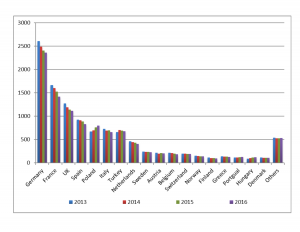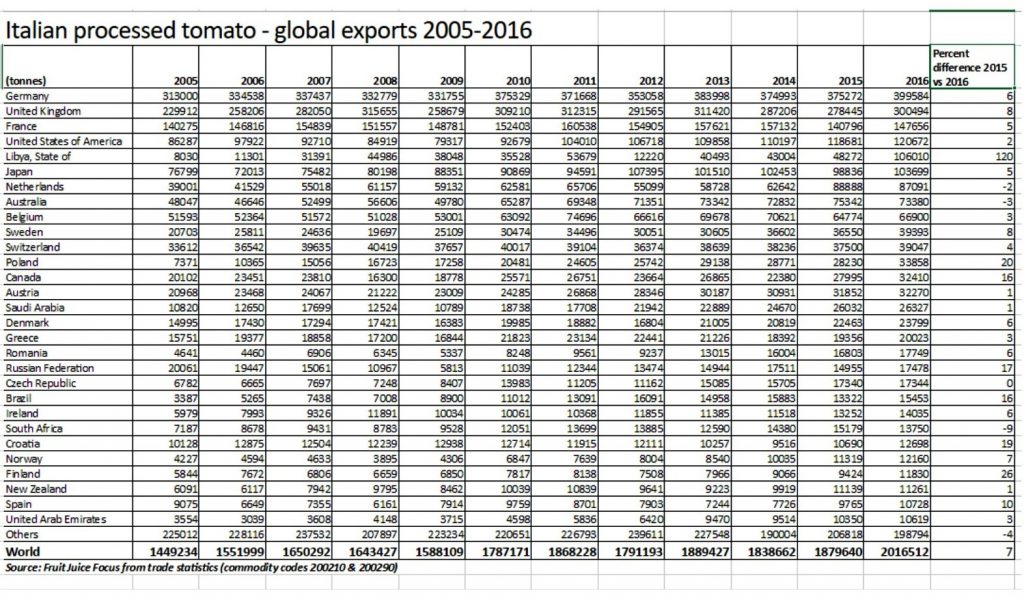Forecast on Brazil’s 2017/18 crop (USDA)
The commercial area of the state of Sao Paulo and the western part of Minas Gerais should produce 364.5 million boxes, up 49% from the previous crop (245.3 million boxes). This projection is based on the Defence Fund for Citriculture’s (Fundecitrus) first citrus crop forecast, released on 10 May 2017.
Total Brazilian FCOJ (65 brix equivalent) production for 2017/18 is forecast at 1.257 million tonnes, up 447 000 tonnes compared with 2016/17, due to higher expected fruit availability for crushing. The Sao Paulo industry is expected to process 320 million boxes for juice production (255 million boxes for FCOJ and 65 million boxes for NFC OJ). This would result in 1.172 million tonnes of juice (920 000 tonnes of FCOJ and 252 000 tonnes of NFC OJ). Other producing states should deliver 20 million boxes for processing.
Total Brazilian FCOJ exports for 2017/18 are forecast at 1.143 million tonnes, up 248 000 tonnes from 2016/17 (895 000 tonnes), due to the expected higher volumes available. The Sao Paulo industry should contribute 840 000 tonnes of FCOJ. These figures include NFC OJ production converted to FCOJ (65 brix equivalent).
The USDA forecasts ending stocks for 2017/18 at 100 000 tonnes (65 brix) up 74 000 tonnes from 2016/17. The USDA figures only include stocks in Brazil. CitrusBR forecasts stocks at 200 000-300 000 tonnes on 30 June 2018. CitrusBR global inventories include orange juice in storage tanks at processing plants and port terminals in Brazil and stocks abroad (vessels and port facilities worldwide).
Brazil – Orange juice (65 brix) – Production, supply and demand
| Tonnes | 2015/16 | 2016/17 | 2017/18 |
| Delivered to processors | 11506000 | 9058000 | 13872000 |
| Beginning stocks | 329000 | 147000 | 24000 |
| Production | 1006000 | 810000 | 1257000 |
| Exports | 1153000 | 895000 | 1143000 |
| Domestic consumption | 35000 | 38000 | 38000 |
| Ending stocks | 147000 | 24000 | 100000 |
Orange juice update – EU-28 (USDA)
Orange juice production in 2016/17 is forecast at 101 941 tonnes (65 brix). Orange juice consumption is forecast to be stable at 826 941 tonnes.
EU-28 is a net importer of orange juice, heavily dependent on third countries to reach the EU-28 orange juice demand. Brazil continues to be the main supplier of orange juice to the EU with around 90% of total imports. In 2015/16 the EU-28 imported 777 825 tonnes of orange juice.
European Union – Orange juice (65 brix) – Production, supply and demand
| Tonnes | 2014/15 | 2015/16 | 2016/17 |
| Delivered to processors | 1251000 | 1286000 | 1315000 |
| Beginning stocks | 15000 | 15000 | 15000 |
| Production | 96980 | 99963 | 101941 |
| Exports | 49870 | 52049 | 50000 |
| Domestic consumption | 936771 | 825468 | 826941 |
| Ending stocks | 15000 | 15000 | 15000 |
Argentina – Lemon (USDA)
Lemon production for 2016/17 is expected to decrease to 1.27 million tonnes from 1.35 million tonnes the year before, due to a late frost, high temperatures and excess rain.
Fresh lemon production in 2015/16 was also negatively impacted by rains towards the end of summer, which delayed the harvest about a month.
Fresh lemon for processing in 2016/17 is estimated at 980 000 tonnes against 1.003 million tonnes the year before.
Following the practice carried out in the past few years, relatively high volumes of fruit are being devoted for processing as a result of the decision made by the industry to export only fresh lemons meeting higher quality standards, thus restricting the export supply and preventing a steep decrease of international prices. This market strategy is working very well and is expected to continue.
South Africa – Orange juice (USDA)
The USDA estimates that production of orange juice in South Africa will increase by 18% to 22 717 tonnes in 2016/17, from 19 317 tonnes in 2015/16.
Domestic consumption is expected to increase by 3% to 6 200 tonnes in 2016/17. The relatively high food price inflation has resulted in restricted growth in the domestic consumption of fresh fruit juices, especially in 100% fruit juice, and a shift in demand to orange juice from concentrates.
Exports of orange juice in 2016/17 are predicted to decrease by 39% to 21 160 tonnes from 34 742 tonnes the year before. This is attributed to the available production, lower opening stocks, lower year-to-date exports up to April 2017 and USDA estimates for the remainder of the season.
Producers in South Africa prefer to export fresh oranges rather than to sell to processors as export prices are eight times higher than prices achieved from processors. Netherlands, Botswana, Mozambique, Mauritius, Zambia and Zimbabwe, are the biggest markets for South African orange juice exports.
South Africa – Orange juice (65 brix) – Production, supply and demand
| Tonnes | 2014/15 | 2015/16 | 2016/17 |
| Delivered to processors | 403000 | 142000 | 167000 |
| Beginning stocks | 25086 | 29003 | 8679 |
| Production | 54821 | 19317 | 22717 |
| Exports | 4548 | 34742 | 21160 |
| Domestic consumption | 6800 | 6000 | 6200 |
| Ending stocks | 29003 | 8679 | 12636 |
New Zealand – Apple and pears (USDA)
Processing volumes of apples in New Zealand for 2016/17 are forecast at 123 000 tonnes, a 12.8% reduction over 2015/16. This is a 14% revision down from the USDA’s initial forecast due to a higher percentage of the crop expected to make export grade.
Apple processing volumes are estimated at 141 087 MT for 2015/16, 12.4% below 2014/15.
The volume of pears going to the processing sector is estimated at 2 000 tonnes for 2016/17 – 200 tonnes higher than in 2015/16.






